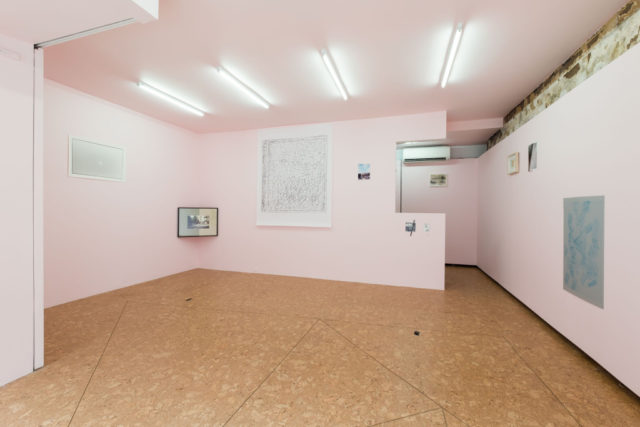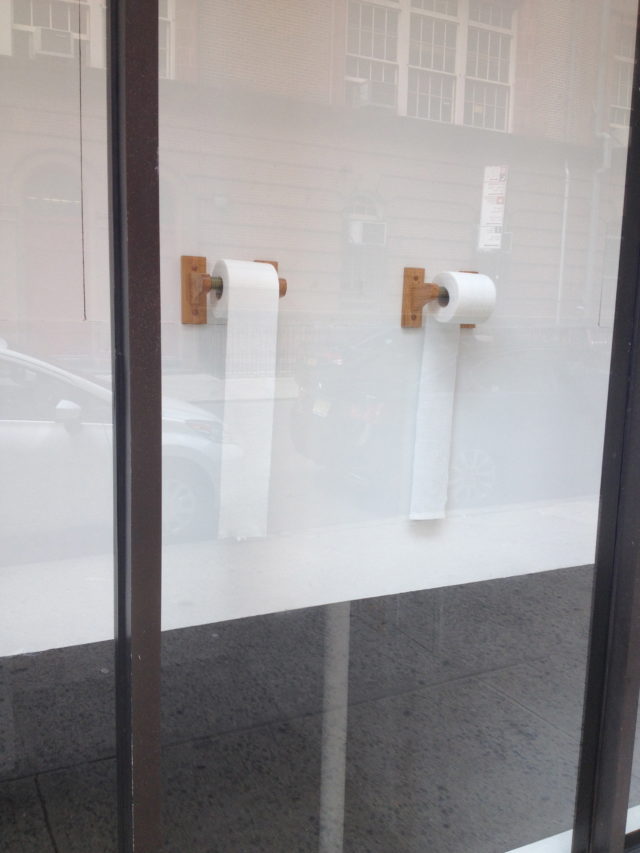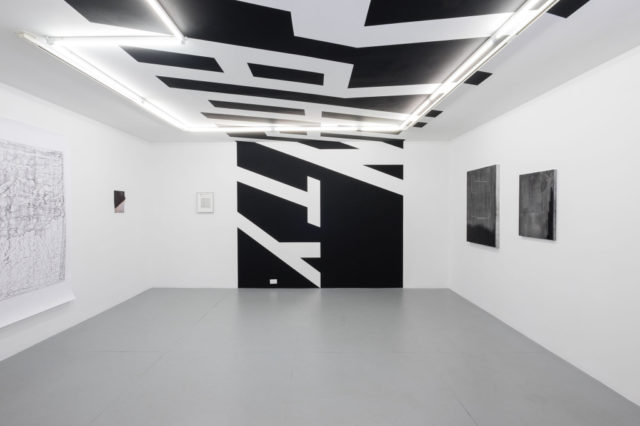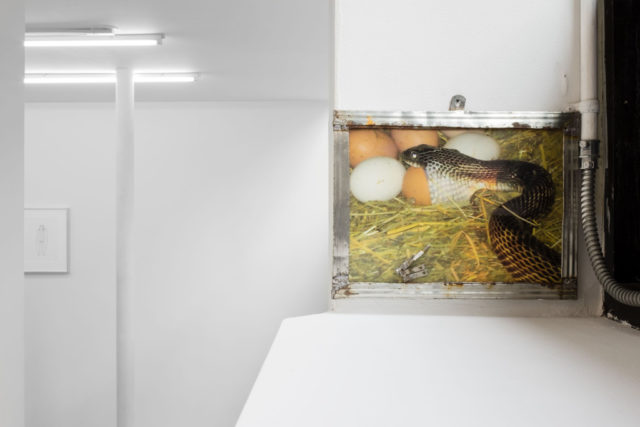
Installation view of P!
Two galleries, P! and Room East—located about five blocks from each other, respectively in Chinatown and the Lower East Side—came together for a group show titled O / U. That’s shorthand for “over-under,” which may refer to the sports wager where you bet on the combined score in a game. The text for the exhibition suggests it may also refer to “a complicated sexual position, a type of double barrel shotgun,” or the formal qualities of overprinting or undercutting. Of course, overall, it suggests that the conceptual layering is heaavy, though the two galleries are spare and clean and contemporary looking.
Pretty and oblique, it was nice to look at and fun to think about, like relishing a thought in the mind the way one rolls a candy in the mouth.
First I went to P!, where Julie Ault, known for her archivistic and curatorial art practice, and Martin Beck, known for his photographs and sculpture, combined their years of experience to paint the ceiling pink. Matthew Schrader did the walls the same hue. It’s a sweet, subduing color for viewing the other work: Schrader’s deep green magnetic film squares, Amy Yao’s rice paper fan (from Beijing to LES, it testifies), and Marcel Broodthaers’ letterpressed photos, the French reminding me that I don’t know French. A standout work for me was Zoe Leonard’s silver gelatin print, whose core could be either a tunnel of light or a requisite blind spot. P! is an atmosphere at once oversaturated and understated, bouncing between over- and underwhelming.

Aki Sasamoto, Under:Over 2015
Unlike the pink one-room of P!, Room East has a top and bottom floor and the look of a well-oiled white cube. First, from the outside, Aki Sasamoto’s toilet paper rolls hang playfully. Showing the two methods of roll placement, they speak to the show’s over/underarching theme: to be over or under, with the one constituting the other. There is a surprisingly rich Wikipedia article about toilet paper orientation that I found while researching: while most etiquette suggests it be placed over, so that it hangs over the roll, there are those who say, “Who cares,” and do it under. Apparently, most Americans do it over, but everyone orients it out of habit.

Installation view, Room East.
Several of the works that are on view at P! also appear at Room East;versions of Marc Handelman’s disappeared buildings and Jessica Dickinson’s graphite topographies, as well as Schrader’s aforementioned squares. Though pristine, there’s a greater sense of malice at Room East. When walking down the stairs, the eyes are drawn immediately to the ledge holding the sign-in sheet, which also has Kate Levant’s print of a snake eating large (and I would assume avian) eggs. This provided some of the bare life content I was looking for in an exhibition partly about domination and submission, but I was happy to not be hit over the head with any particular interpretation of the show’s thrust.
Other standout works include Karel Martens’ trippy pointillism by way of letterpress (it makes sense that the show has a lot of this method); Ebecho Muslimova’s ink drawings of figures in a sort of cartoonish, semi-bondage; and Michael Assiff’s easy-to-miss sunflower faceplate on one of the gallery’s junction boxes. However, Miles Huston’s stack of produce boxes didn’t speak to me, and felt a bit obvious (over, under, over, etc.)

Kate Levant at Room East.
Shifting back to P!, the drawback there is the sense of emptiness that can accompany a lot of contemporary art. Though aesthetically appealing, I did have moments of “Why am I looking at this?” Clearly, many of the 25 artists in this double gallery group show are well established, having shown at many a museum and biennale, but given the process-heavy methods of a lot of these artists, it can feel flat at times.
I wonder if this is part of the idea, though: that art itself is always asserting both its dominance (“I am art, and thus different from everything.”) and its submission (“I am art, and thus am nothing, or, can be anything.”). The exhibition text mentions Nietzsche’s übermensch, the overman who will assert his own values in place of religious emphasis on otherworldliness. The text also mentions the underdog, as in David v. Goliath, Seahawks v. Patriots, Snowden v. NSA. Though I enjoyed the show, I wish there was more literal exploration of these concepts, rather than process-heavy abstraction.
This is why, in the context of the whole exhibition, Levant’s imperious snake takes the cake. Ominously consuming, jolting, it slithers near the sign-in sheet, a warning (or invitation?) to those who enter.


Comments on this entry are closed.